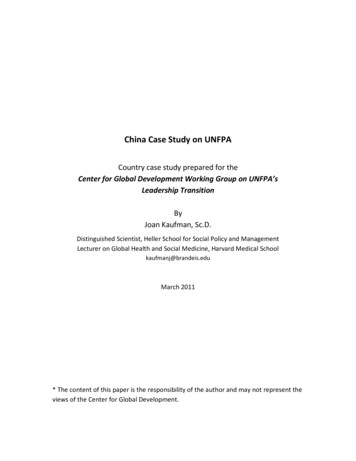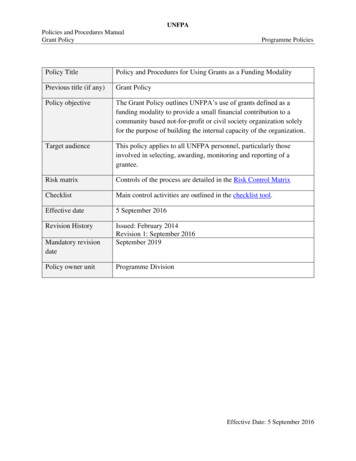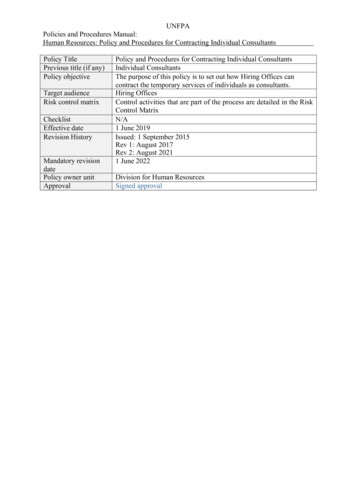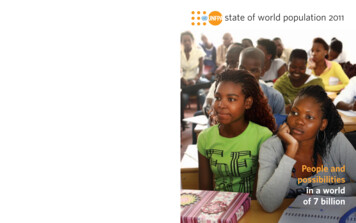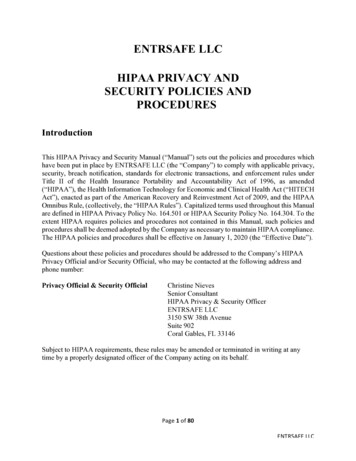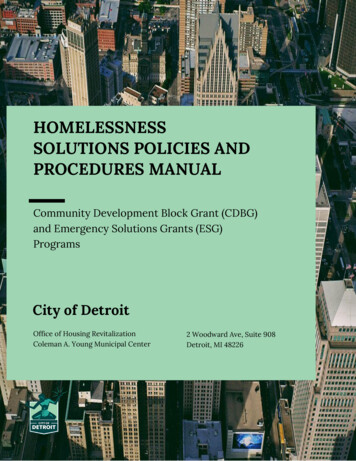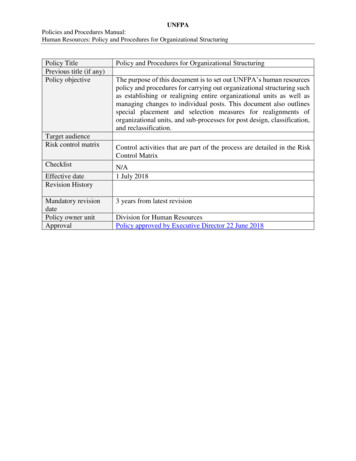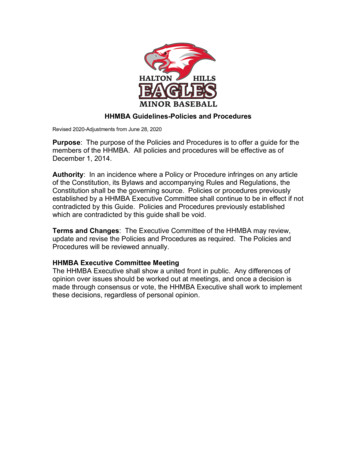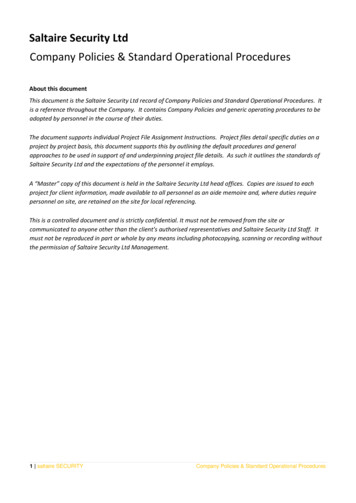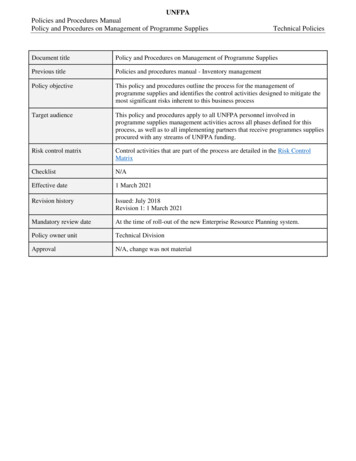
Transcription
UNFPAPolicies and Procedures ManualPolicy and Procedures on Management of Programme SuppliesTechnical PoliciesDocument titlePolicy and Procedures on Management of Programme SuppliesPrevious titlePolicies and procedures manual - Inventory managementPolicy objectiveThis policy and procedures outline the process for the management ofprogramme supplies and identifies the control activities designed to mitigate themost significant risks inherent to this business processTarget audienceThis policy and procedures apply to all UNFPA personnel involved inprogramme supplies management activities across all phases defined for thisprocess, as well as to all implementing partners that receive programmes suppliesprocured with any streams of UNFPA funding.Risk control matrixControl activities that are part of the process are detailed in the Risk ControlMatrixChecklistN/AEffective date1 March 2021Revision historyIssued: July 2018Revision 1: 1 March 2021Mandatory review dateAt the time of roll-out of the new Enterprise Resource Planning system.Policy owner unitTechnical DivisionApprovalN/A, change was not material
UNFPAPolicies and Procedures ManualPolicy and Procedures on Management of Programme SuppliesTechnical PoliciesTable of contentsI.Purpose1II.Policy1Key policy requirements1Definitions3Types of programme supplies3General definitions4Systems overview8OTS Terms9Roles and ResponsibilitiesIII.A.ProceduresSupply quantificationStep 1 – Needs assessment and forecasting9141415RH commodities15Medical equipment16Humanitarian supplies16National coordination mechanisms17Forecasts and needs assessments review18Step 2 – Supply prioritization18Step 3 - Procurement planning19B.Procurement plan preparation19Procurement plan review and approval20Procurement plan implementation monitoring20SourcingStep 4 - Requisitions2021Requisition creation21Procurement of Non-LTA items22Requisition approval22Requisition review23Requisition status monitoring23Step 5 – Sourcing235.1 – Sourcing from fresh production24Purchase order creation24Issued July 2018Revision 1: Effective Date: 1 March 2021
UNFPAPolicies and Procedures ManualPolicy and Procedures on Management of Programme SuppliesPurchase order review and approval25Purchase order dispatch25Freight sourcing25Incoterms265.2 – Sourcing from PSB stock26Inventory order creation27Pick plan creation27Freight sourcing27Step 6 - Pre-shipment activitiesC.Technical Policies27Pre-shipment quality assurance - international procurement28Pre-shipment quality assurance – PSB stock29Pre-shipment quality assurance – local procurement29Shipping documents29Pre-shipment checks and coordination31FulfillmentStep 7 - Shipping3132Consignee32Shipment commencement33Financial receipt33IMM inventory order depletion34Shipment Tracker update34Insurance arrangements34Step 8 - Tracking of shipments34Step 9 - Goods arrival and customs clearance35Monitoring of customs clearance activities36Customs inspections36Use of third-party service providers36Insurance arrangements36Quality assurance considerations37Process for goods procured by field offices37Customs clearance costs37D.DeliveryStep 10 – Receiving and inspectionScope of inspection373738Issued July 2018Revision 1: Effective Date: 1 March 2021
UNFPAPolicies and Procedures ManualPolicy and Procedures on Management of Programme SuppliesReceiving and inspection forms40Discrepancies41Shipment Tracker update42Post-shipment inspection and testing42Step 11 - Storage42Authorization to hold inventory42PSB-managed stocks43Selection of field office warehouses43WHO Good Storage and Distribution Practices for Medical Products44Warehouse location and design44Storage conditions45Warehouse personnel47Insurance arrangements48Disposal of goods48Returned goods48Repackaging and relabeling49Step 12 - HandoverE.Technical Policies49In country transportation49Handover approval and coordination50Handover of goods upon arrival51Handover of goods from UNFPA warehouses51Delivery slips51Direct distribution52Shipment Tracker update52Handover - expired and expiring goods52Handover of goods consigned to other parties53Distribution of goods by IPs54Quality Incidents, Complaints and recall considerations54Accounting and controlStep 13 – Inventory accounting5455Control and recognition55Recognition of field office inventory transactions56Recognition of contributions in-kind56Recognition of field office inventory balances57Issued July 2018Revision 1: Effective Date: 1 March 2021
UNFPAPolicies and Procedures ManualPolicy and Procedures on Management of Programme SuppliesTechnical PoliciesRecognition of PSB-controlled inventory transactions and balances57Valuation of inventory57Step 14 - Inventory Controls57Inventory transactions reconciliations58Inventory balances certifications58Stock counts58Inventory adjustments58Inventory write-offs59Segregation of duties requirements59Fraud risk mitigation59Step 15 – Monitoring and AssuranceF.60Supply-chain maps60Supply-chain management capacity assessments61Supply-chain management risk assessments62IP reporting62Inventory spot-checks and audits62Other monitoring activities62Process governance63Roles and responsibilities63Implementing partner agreements63Workplans64Recovery of losses64Issued July 2018Revision 1: Effective Date: 1 March 2021
UNFPAPolicies and Procedures ManualPolicy and Procedures on Management of Programme SuppliesI.Technical PoliciesPurpose1.2.II.This policy and procedures document establishes the processes, procedures and internal controls, aswell as the related roles and responsibilities and support systems, for the effective management ofUNFPA programme supplies, which are defined in paragraphs 4 to 7 below.The main objectives of this policy and procedures document are:1) Promote a disciplined application of good practices across the different phases of the supplychain, to ensure the effectiveness and efficiency of UNFPA’s supply-chain managementactivities, and contribute to the achievement of strategic objectives in the related programmeareas.2) Ensure that programme supplies are properly safeguarded, stored and managed, to avoidspoilage, waste and theft, while under control of UNFPA or its implementing partners.3) Ensure inventory transactions are accurately and timely recorded.4) Ensure programme supplies inventories are accurately valued and reported in accordance withthe applicable accounting standards.5) Allow UNFPA to discharge its fiduciary obligations to donors and suppliers, by obtainingreasonable assurance about the use of programme supplies for the intended purposes.6) Ensure that the quality of RH commodities is maintained through the supply-chain down to thepoints of use, so that the efficacy and safety of the products is preserved.7) Outline the roles and responsibilities of the business units and of the relevant personnel involvedin the key business processes tasks.PolicyKey policy requirements3.This policy outlines the processes to be followed for the management of programme supplies, identifieskey control actions to mitigate risks inherent to the process and establishes the key requirementsoutlined below:1) Any goods to be provided by UNFPA to address relevant country needs and contribute to theachievement of programme results must be identified based on rigorous needs assessments andquantifications. In the acute phase of humanitarian emergencies, the Minimum Initial ServicePackage (MISP) for SRH, rapid assessments for GBV and any other available pre-crisis datashould be the basis of the needs assessments.2) Multi-year forecasts must be developed with an appropriate periodicity, at least annually, incoordination with the relevant national and development/humanitarian partners and stakeholders,at all countries where UNFPA provides reproductive health (RH) commodities or otherprogramme supplies on a regular basis, or as a component of preparedness for response tohumanitarian crises.3) The identification and prioritization of the RH commodities to be provided by UNFPA must bemade based on comprehensive, national level, supply plans.4) All programme supplies requirements must be consolidated into comprehensive procurementplans, updated and tracked for implementation at least on a quarterly basis.5) Procurement plans and requisitions must be reviewed and approved by the Commodity SecurityBranch (CSB), the Humanitarian Office (HO) or regional offices, as specified in differentsections of this policy and procedures document.6) The sourcing of programme supplies orders must follow the UNFPA procurement procedures.7) Procurement of contraceptives can only be made by the Procurement Services Branch (PSB).1Issued July 2018Effective Date: 1 March 2021
UNFPAPolicies and Procedures ManualPolicy and Procedures on Management of Programme SuppliesTechnical Policies8) Procurement of pharmaceuticals and medical devices can only be undertaken by UNFPA. Localprocurement of pharmaceutical products and medical devices must be undertaken on anexceptional basis, pre-approved by PSB, and subject to quality assurance in accordance with theapplicable policies and procedures.9) The Order Tracking System (OTS) must be updated on a continuous basis by all responsibleparties (e.g., suppliers, freight services providers, PSB Logistics and Shipping Unit) to ensurethat all relevant information and notifications are available to receiving field offices, includingalerts to any changes in delivery dates.10) Field offices must review shipping documents and coordinate all necessary local activities priorto shipment, and notify procurement focal points of any situations that could prevent or delay thecustoms clearance, receipt or delivery of goods at least two weeks prior to the estimated time ofdeparture date. A shorter timeframe may be required for acute humanitarian responseinterventions.11) Programme supplies must normally be consigned to UNFPA unless exceptional circumstancesprevent such arrangement or the use of a consignee other than UNFPA will result in lower costs,reduced lead times or improved access.12) Field offices must continuously track the status of shipments and communicate any delays in thearrival of goods to the procurement focal points.13) Customs clearance activities must be timely completed, based on country-specific standardoperating procedures, with the involvement of field office personnel, even when the process isoutsourced to professional customs clearing agents or customs brokers.14) Field offices must conduct detailed inspections of shipments immediately after the arrival andcustoms clearance of the goods, and document their outcome in detailed receiving and inspectionreports.15) Field offices must promptly document and bring to the attention of PSB any discrepancies,shortages and/or damages identified during the customs inspections or the receiving inspections.16) Field offices must seek prior regional office authorization to hold inventory at UNFPAwarehouses (including those managed by third-party services providers, other United Nationsorganizations or programme partners). This requirement is temporarily waived for warehousesengaged under Fast Track Procedures.17) Facilities to be used for holding programme supplies by UNFPA must be assessed to determinethat they meet the requirements for adequate storage and safeguarding of the inventory, beproperly insured, and approved by regional offices.18) Product conditions must be monitored regularly, and defects or damages identified reportedpromptly so that remedial actions can be taken.19) In order to maintain the approved quality, safety and efficacy/performance throughout the supplychain, RH commodities must be handled and managed in compliance with the WHO GoodStorage and Distribution Practices for Medical Products, the key requirements of which arereflected in the appropriate sections of this policy, and any applicable national regulatory controlsfor controlled substances.20) Only products that have been stored and transported under approved conditions can be distributedto beneficiaries.21) Inventory maintained at field offices warehouses, including those managed by third-partyservices providers, other United Nations organizations or programme partners, must be insuredat all times.2Issued July 2018Effective Date: 1 March 2021
UNFPAPolicies and Procedures ManualPolicy and Procedures on Management of Programme SuppliesTechnical Policies22) Disposal of programme supplies must be carried out in accordance with the applicableenvironmental, health and safety standards. Disposal of RH commodities other thancontraceptives must be pre-authorized by the PSB QA team.23) UNFPA programme supplies can be provided only to partners that have valid implementingpartner (IP) agreements with UNFPA and signed workplans or other appropriate programmedocuments specifying the products to be provided by UNFPA and their intended use.24) Handover of UNFPA programme supplies to IPs must be pre-approved and documented throughdelivery slips to be signed by the appropriate IP personnel at the time the goods are delivered atIP warehouses.25) In exceptional circumstances, mainly in the context of humanitarian response interventions, andad-hoc, onetime activities, programme supplies can be provided to partners without valid IPagreements using Programme Supplies Distribution Agreements (PSDA), as long as certainqualifying conditions are met.26) Inventory receipts and deliveries must be timely recorded in the Shipment Tracker immediatelyafter the transactions have been completed.27) Shipment Tracker inventory transactions and balances must be reconciled by field offices againstshipping documents, receiving and inspection reports, handover documents, stock count reportsand other appropriate supporting documents.28) Field offices must complete inventory stock-counts and certifications in order to confirm theaccuracy and completeness of their inventory balances, with the frequency required in theinventory certification process guidelines.29) Visibility and assurance regarding the adequate safeguarding, management, and use for intendedpurposes of programme supplies after their handover must be obtained through the activitiesencompassed in the Last Mile Assurance (LMA) process as described in the correspondent LMAprocess guidance notes incorporated into this policy by reference.30) Field offices must monitor the effectiveness of their supply-chain management activities throughthe inclusion of appropriate outputs and indicators in their annual management plans and in theperformance plans of personnel responsible for those activities.31) The operating effectiveness of the processes must be regularly monitored through ’second lineof defense’ controls, such as the periodic generation and analysis of exception reports from Atlasand other available sources, and regular stock counts.32) IPs are required to reimburse to UNFPA the value of any waste and losses affecting programmesupplies provided by UNFPA in excess of the risk appetite and acceptance thresholds establishedby UNFPA.DefinitionsFor purposes of this policy and procedures document, ‘programme supplies’, also referred to as‘inventory’ or ‘goods’ (all three terms are used interchangeably throughout this document), are definedas RH commodities and other goods acquired by UNFPA for use in its programmes, as defined inparagraphs 5 to 7 below. Programme supplies are primarily delivered to IPs for their use or distributionto beneficiaries.Types of programme supplies4.5.In accordance with the above definition, programme supplies include:1) Contraceptives, hormonal contraceptives and other contraceptive devices e.g. male and femalecondoms, and intrauterine devices (IUDs).2) Medical devices and supplies, such as hospital equipment, surgical instruments, consumables,personal protective equipment (PPE) and diagnostic equipment and supplies.3Issued July 2018Effective Date: 1 March 2021
UNFPAPolicies and Procedures ManualPolicy and Procedures on Management of Programme SuppliesTechnical Policies3) Pharmaceutical products, including life-saving medicines.4) Interagency Emergency Reproductive Health Kits (IARH), fistula repair, and reproductive &maternal health kits.5) Dignity and other relevant non-food items (NFI) kits.6) Census equipment and supplies.7) Other goods purchased for delivery to and use or distribution by IPs.6.The following types of goods are excluded from the definition of programme supplies and thus falloutside of the scope of this document:1) Items similar to fixed assets, as defined in the UNFPA Policy and Procedures for Fixed AssetManagement, such as vehicles and information and communications technology (ICT)equipment, procured for (i) use by UNFPA; or (ii) delivery to IPs for purposes other than censusesand humanitarian response activities.2) Materials and supplies purchased for use by UNFPA personnel.3) Printed materials and publications, such as manuals, reports, forms and questionnaires, unlesspurchased for censuses or large-scale programme activities.4) Supplies specifically procured for use in capacity building or public awareness events, such aspromotional and visibility items.5) Goods procured by PSB on behalf of third-party procurement services clients through purchaseorders (i.e., third-party procurement orders sourced from fresh production).7.All programme supplies held under control of PSB, used to fulfill field office and third-partyprocurement orders, are considered inventory and fall under the scope of this policy.General definitions8.The following terms are used throughout this policy with the meanings specified below:1) Atlas – UNFPA’s PeopleSoft-based Enterprise Resource Planning (ERP) system.2) Census equipment and supplies – the equipment and supplies required for census activitiesduring the preparatory, cartography, enumeration, processing and dissemination phases,including (but not limited to) data capture devices (e.g., smart phones and tablets), scanningequipment, computers and servers, census forms, enumerators supplies (e.g., stationery, satchels,backpacks), clothes (e.g., caps, shirts), office furniture and equipment, and vehicles.3) Consignee – the party named in the shipping documents as the recipient of goods shipped at thefinal destination. The consignee is considered the owner of the goods for customs clearancepurposes.4) Commitment Control (KK) – the Atlas module that allows UNFPA to control expendituresagainst predefined, authorized budgets, cash available and authorized spending limits. All Atlastransactions are budget-checked against resources available in KK.5) Due date – the projected date of transfer of control over goods from suppliers to UNFPA basedon the associated incoterms, as indicated in the purchase orders based on the applicable contractsand agreements with suppliers on delivery lead times. It may be amended at any time throughoutthe order fulfilment process, at UNFPA’s request or in response to force majeure situations.6) Electronic signature – the digitized version of a handwritten signature electronically affixed toa document, normally through use of an e-signature solution, such as DocuSign or Adobe Sign.7) Emergency procurement procedures – the streamlined procurement procedures applied byfield offices, when authorized, following the process established in the UNFPA Fast TrackPolicies and Procedures.4Issued July 2018Effective Date: 1 March 2021
UNFPAPolicies and Procedures ManualPolicy and Procedures on Management of Programme SuppliesTechnical Policies8) Fast track procedures (FTP) – a set of procedures providing UNFPA field offices with greaterdelegation of authority and flexibility in specific programme and operational areas for a timebound period, typically to facilitate humanitarian response activities. They represent amodification to the standard policies and procedures, as described in the UNFPA Fast TrackPolicies and Procedures document, and are designed to facilitate a rapid response to countryneeds.9) Field office – any UNFPA regional, sub-regional or country office.10) Final destination or place of delivery – the location designated as the final destination of cargo(e.g. Maputo, Mozambique) where the supplier or freight forwarder is contracted to deliver thegoods to and where these goods are expected to be collected by the consignee. It normally appearsin the ‘Airport of Destination’ field on the air waybill or ‘Final Place of Delivery’ field on thebill of lading or waybill.11) Financial receipt – the transaction created in Atlas upon satisfactory delivery of goods orservices by suppliers. Delivery of goods occurs when the risks and rewards associated with theirownership are transferred from the supplier to the consignee, and therefore varies depending onthe incoterm used. The financial receipt transaction has significant financial and accountingimplications, as it results in the recognition of assets or expenses and liabilities.12) Fresh production (sourcing from) – the process of procuring goods from suppliers throughpurchase orders.13) General ledger (GL) – the master set of accounts used to record financial transactions, used asa basis for statutory, donor and managerial financial reporting.14) Handover1 – the transfer of control and risks over goods from UNFPA to a third party, typicallyan IP.15) Handover documents – the documents signed between UNFPA and recipients to documenttransfer of physical custodianship and control over the programme supplies in the specifiedquantities and condition. Handover documents include delivery slips, PSDAs and distributionlists signed by goods recipients.16) Humanitarian supplies – any programme supplies intended for distribution as part of UNFPAhumanitarian response interventions, to ensure the health, hygiene, dignity and well-being ofaffected populations. In the context of UNFPA’s mandate, humanitarian supplies primarilyconsist of IARH kits, dignity kits and other related NFI kits, menstrual hygiene managementsupplies, diagnostic kits, medical devices, medical equipment, and items similar to fixed assets,such as mobile clinics, pre-fabs, armored vehicles, generators, and solar panels, if acquired aspart of humanitarian response activities.17) Implementing Partner (IP) – an entity to which UNFPA has entrusted the implementation ofprogramme activities specified in a signed document, along with the assumption of fullresponsibility and accountability for the effective use of UNFPA resources and the delivery ofoutputs as set forth in such programme documentation.18) Incoterms – the standard terms, established by the International Chamber of Commerce definingthe obligations of both buyers and sellers relating to the shipment of goods. The scope ofincoterms is limited to matters relating to the rights and obligations of the parties to the contractof sale with respect to the tasks, costs and risks related to the delivery of goods. Incotermstypically used by UNFPA include:a) Carriage Paid To (CPT) – the normal incoterm rule of reference for UNFPA internationalprocurement. Under CPT, the seller pays the freight for the carriage of the goods to theplace of delivery. However, the risk of loss or damage to the goods passes from the seller1‘Handover’ represents the same process that is referred to as ‘distribution’ in the Shipment Tracker.5Issued July 2018Effective Date: 1 March 2021
UNFPAPolicies and Procedures ManualPolicy and Procedures on Management of Programme SuppliesTechnical Policiesto the buyer when the goods are transferred into the custody of the first carrier.2 The CPTincoterm rule requires the seller to clear the goods for export;b) Free Carrier (FCA) – the incoterm rule typically used when the goods and freight arecontracted by UNFPA from different parties; andc) Delivered At Place (DAP) – the typical incoterm rule of reference for local procurement.Under DAP the seller is responsible for all costs and risks of transportation, includinginsurance, until the delivery of the goods to the final destination.19) In-kind donations of inventories – any goods received at nominal or no cost to UNFPA.20) Internal control framework (ICF) – the policies, procedures, standards, processes andstructures put in place to ensure an orderly, ethical, economical, efficient and effective use ofresources.21) International procurement – the procurement carried out by PSB. Purchase orders forinternationally procured goods must be raised under the business unit (BU) ‘UNFPA’.22) Inventory in stock (also referred to as static inventory) – the inventory controlled by UNFPAand held in warehouses. Inventory in stock typically falls into either one of the followingscenarios:a) PSB-controlled stock of RH commodities and humanitarian supplies, typically stored atsuppliers’ facilities or the premises of other UN organizations; andb) Inventory held in warehouses by field offices.23) Inventory in transit – the inventory controlled by UNFPA that has not yet reached its finaldestination - for example, goods on board of a ship in route to the port of entry. Inventory intransit typically falls into either one of the following scenarios:a) Internationally procured goods that have not yet been physically received, including thosetemporarily stationed at the port of entry pending completion of customs clearanceactivities; orb) Physically received goods being transported within the country of final destination thathave not yet been delivered to a UNFPA warehouse or handed over to an IP.24) Inventory order – an order fulfilled from PSB-controlled stock of RH commodities andhumanitarian supplies.25) Last mile assurance – a process designed to provide visibility and assurance regarding theadequate safeguarding, management and use for intended purposes of programme supplies aftertheir handover to partners, and until they reach the designated service delivery points wherebeneficiaries can access them, i.e., the “last mile”. The process comprises five differentcomponents: (i) supply-chain maps, (ii) supply-chain management capacity assessments, (iii)supply-chain management risk assessments, (iv) programme supplies reports, and (v) spotchecks and audits.26) Local procurement – the procurement carried out by UNFPA field offices. It includessolicitations from both local and international suppliers. Purchase orders for locally procuredgoods must be raised under the field offices business unit codes in Atlas, which normallycombine a three letter country code and the number ‘40’.27) Long term agreement (LTA) – a contract concluded with a supplier on a non-exclusive basisfor the repeated purchase of certain goods or services, based on pre-established terms andconditions (e.g., price per unit, quality levels, ordering method and lead times) for a definiteperiod of time but with no legal obligation to order any minimum or maximum quantities.2Carrier means any person who, in contract of carriage, undertakes to perform or to procure the performance of carriage, by rail, road, sea,air, inland waterway or by a combination of such modes.6Issued July 2018Effective Date: 1 March 2021
UNFPAPolicies and Procedures ManualPolicy and Procedures on Management of Programme SuppliesTechnical Policies28) Personal protective equipment (PPE) – a category of medical devices used to protect healthcare workers or any other persons from an infectious disease, including gowns, coveralls,gloves, face shields, goggles, facemasks, respirators, head covers, boot covers, aprons and otheritems depending on the disease outbreak.29) Pick plan – a transaction created in the Atlas Inventory Management module (IMM), whichshows details of the goods to be released from PSB stock to fulfil an inventory order.30) Physical receipt – the receipt of the goods in the country of destination, after completion ofcustoms clearance and receiving and inspection procedures.31) Port of entry – the place where imported goods are admitted into the legal frontiers of theimporting country. In the context of the policy, this term is used to represent the port of entryin the country of final destination.32) Purchase order – a contract created in the Atlas Purchasing module that represents a bindingcommitment between UNFPA and a supplier for the provision of goods or services.33) Reproductive health (RH) commodities - contraceptives (hormonal and contraceptivedevices), pharmaceutical products and medical devices used to support RH interventions. RHcommodities primarily comprise:a) Goods included in the Interagency List of Essential Medicines for Reproductive Healthsuch as contraceptives; medicines for prevention and treatment of sexually transmittedinfections and HIV/AIDS; and maternal and neonatal health medicines; andb) Goods included in the Interagency list of medical devices for essential interventions forreproductive, maternal, newborn and child health, such as medical consumables; medicalequipment; and medical kits that are essential to maternal and newborn healthinterventions.34) Requisition – the transaction created in Atlas by users to authorize and initiate the procurementof goods and / or services.35) Supplier or vendor – the entity that provides goods or services to UNFPA. A supplier or vendormay take various forms, including a company, a partnership, a government agency or a nongovernmental organization.36) UNFPA Supplies Partnership – the UNFPA thematic programme dedicated to expandingaccess to family planning and life-saving maternal health commodities. UNFPA SuppliesPartnership supports countries with the greatest needs, helping them to strengthen their supplychains so that women and adolescent girls can access a choice of contraceptives no matter wherethey live.37) Warehouse – any facility used to store programme supplies by UNFPA or IPs.38) UNFPA warehouse – any warehouse used for storage of supplies controlled by UNFPA,including:a) UNFPA-managed warehouses (i.e., warehouses managed by UNFPA personnel), whichcan operate in fac
Previous title Policies and procedures manual - Inventory management Policy objective This policy and procedures outline the process for the management of programme supplies and identifies the control activities designed to mitigate the most significant risks inherent to this business process Target audience This policy and procedures apply to all UNFPA personnel involved in programme supplies .

